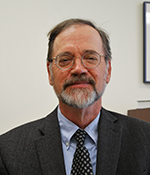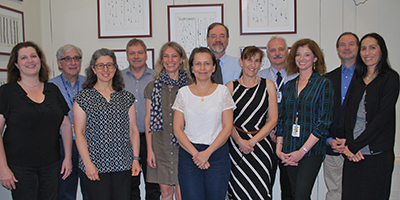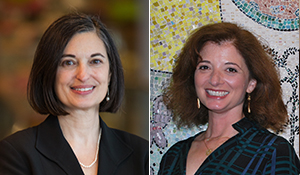

Teamwork Tackles Rare Diseases
Einstein's IDDRC and the Children's Hospital at Montefiore: Teaming Up to Tackle Rare Childhood Diseases
One afternoon in early spring, Dr. Steven Walkley took down a heavy tome from a shelf in his office bookcase at the Rose F. Kennedy Intellectual and Developmental Disabilities Center (RFK IDDRC). He turned to the page containing his favorite medical quote and read it aloud to a visitor:

Steven Walkley, Ph.D., DVM“Nature is nowhere accustomed more openly to display her secret mysteries than in cases where she shows tracings of her workings apart from the beaten paths; nor is there any better way to advance the proper practice of medicine than to give our minds to the discovery of the usual law of nature, by careful investigation of cases of rarer forms of disease.”
“These are the words of the great 17th -century English physician William Harvey,” he explained. “They were written in 1657 and have been a touchstone for me in my work.”
For more than 25 years, Dr. Walkley, who is professor in the Dominick P. Purpura Department of Neuroscience, of pathology and in the Saul R. Korey Department of Neurology, and director of Einstein’s RFK IDDRC, has been working to uncover the biological origins of Niemann-Pick type C disease—a debilitating and deadly brain disorder that affects children—and to find an effective treatment.
Niemann-Pick type C is a lysosomal storage disorder. It’s one of approximately 7,000 rare diseases that affect about 350 million people worldwide, nearly half of whom are children. Most have no known treatments, and many are fatal. About 30 million Americans, or about 1 in 10, are living with rare diseases.
Leveraging an Unusual Discovery
In the 1990s, Dr. Walkley’s team discovered miglustat, the first drug to slow NPC. But its beneficial effects were limited. Years later, spurred by a report about a steroid that a team of investigators had found effective in treating NPC, Dr. Walkley decided to “see if there was a synergy between miglustat and the steroid.”
“My lab assistant, Dr. Cristin Davidson, ran the studies. She dissolved the steroid in a solvent called cyclodextrin,” recalled Dr. Walkley.

IDDRC researchers and CHAM physicians meet periodically with parents of children with rare diseases to gain insights into issues and ideas for their investigations. Pictured (from left): Monica Coenraads, Robert Marion, M.D., Michelle Gavens, Vytautas Verselis, Ph.D., Sophie Molholm, Ph.D., Paola Jordan, Steven Walkley, Ph.D., Bernice Morrow, Ph.D., Craig Branch, M.D., Melissa Wasserstein, M.D., Phil Marella and Sheila Kambin “She used several control groups of mice in the combination miglustat-steroid study, including one group injected just with the vehicle, cyclodextrin. To her surprise, she noticed that the mice injected only with cyclodextrin were walking just as well as the mice injected with the steroid that had been dissolved in the solvent. This suggested that it was the solvent, and not the steroid, that was responsible. ”
In 2007, Dr. Walkley worked with a group of parents, scientists and clinicians to form Support of Accelerated Research, or SOAR, a research collaborative dedicated to accelerating the discovery of a better treatment for NPC. Partnering with scientists and clinicians at the National Institutes of Health (NIH), SOAR succeeded in getting cyclodextrin approved for clinical trials. Phase 1, focusing on safety, launched in 2013. Phase 2, to determine the drug’s efficacy, began this year. (Please see related video.)
A Tradition of Translational Research
The Walkley lab’s work on NPC represents a longstanding tradition of translational research at the RFK IDDRC that has been encouraged from Einstein’s very beginnings—years before the now popular term was coined.
Dr. Saul Korey, who established the neurology department at Einstein in the late 1950s, introduced what was then an unusual research approach: conducting collaborative studies in the lab to address questions that arose from physicians’ work in the clinic. Dr. Korey’s focus on Tay-Sachs disease led to a number of important discoveries and collaborations, including research by Dr. Dominick Purpura that led Dr. Walkley, then a postdoctoral researcher at University of Alabama, to come north to the Bronx and begin his work at Einstein. Since taking the helm of the RFK IDDRC in 2010, Dr. Walkley has made it his mission to reinvigorate the center’s strong culture of collaboration across broad disciplines. His efforts have paid off. In 2011, the RFK IDDRC received one of the highest possible scores from the NIH’s Eunice Kennedy Shriver National Institute of Child Health and Human Development along with a $5.7 million renewal grant.
Together with associate director Dr. Sophie Molholm, head of clinical research at the Children’s Evaluation and Rehabilitation Center (CERC), the RFK IDDRC’s clinical arm, Dr. Walkley continues to foster a research environment that’s keeping Dr. Korey’s legacy thriving. In addition to Niemann-Pick type C and other genetic and neurometabolic disorders, RFK IDDRC scientists and clinicians are planning and/or conducting collaborative studies on autism, tuberous sclerosis, and Rett, Fragile X and Williams syndromes.
Bringing Bench-to-Bedside to the Next Level
The recent historic agreement between Einstein and Montefiore has sparked an exciting new era of synergy between research and clinical care.
Dr. Judy Aschner, the Michael I. Cohen University Chair of Pediatrics and physician-in-chief at the Children’s Hospital at Montefiore (CHAM), is working to strengthen the already close ties among CHAM, CERC and the IDDRC.
She recently recruited Dr. Melissa Wasserstein, a nationally known biochemical geneticist, to lead the pediatric genetic medicine division at CHAM.

Judy Aschner, M.D.; Melissa Wasserstein, M.D.“Melissa brings a whole new dimension to pediatric genetic medicine at Einstein and Montefiore. Her recruitment opens new avenues for translational research focused on children with genetically determined developmental disabilities. Her particular expertise in lysosomal storage diseases (LSDs), coupled with her vast clinical trials experience, is the perfect counterpart for the basic/translational work in the Walkley lab. Together they are an LSDs dream team poised to make breakthrough discoveries and translate them to improve the lives of children and their families,” said Dr. Aschner. Dr. Wasserstein succeeds clinical geneticist Dr. Bob Marion in leading the division. “We’re now in a perfect position to combine our strength in clinical genetics with a strong biochemical genetic medicine component to create a truly exceptional program,” added Dr. Aschner.
Dr. Wasserstein, who specializes in precision medicine for patients with multiple inborn errors of metabolism, is an expert in Niemann-Pick types A and B. She and Dr. Walkley will work together to realize a shared vision: making Einstein-Montefiore the place in the greater New York area for lysosomal disease treatment and research.
Taking the Bench to the Clinic
Among the many dedicated researchers at the IDDRC is Dr. Bernice Morrow, whose lab is investigating 22q11.2 deletion syndrome (22q11.2DS), also known as velo-cardio-facial syndrome/DiGeorge syndrome. Dr. Morrow looks forward to another new development: a multi-disciplinary 22q11.2DS clinic at CHAM.
“Genetic research is a numbers game,” she explained. “It’s one thing to work with mouse models, but finding enough human DNA samples for a statistically valid study is an ongoing challenge.”
To address the problem, she co-founded an international consortium that has collected more than 2,000 genetic samples from patients in the United States and in Europe. Now, there may soon be a resource closer to home, thanks to the efforts of Dr. Aschner and her team. “Few places in the country are as well-equipped as we are to make meaningful progress on 22q11.2DS,” said Dr. Aschner. “Our multidisciplinary team of basic and clinical/translational scientists will collaborate with the clinicians who care for these patients to address many unanswered questions about the factors that influence patient outcomes in this complex genetic syndrome.”

Sophie Molholm, Ph.D.; Bernice Morrow, Ph.D.“By pulling all these services together under one roof, we can address all of a family’s clinical needs—and offer them opportunities to participate in clinical research and translational medicine studies that may really have an impact.”
Why Study Rare Diseases?
Rare childhood diseases affect a relatively small portion of the population. So why is it important to study them?
“People ask me this question all the time,” said Dr. Walkley. “And I tell them, first of all, that the answer is obvious when you get to know the children and families whose lives are upended by these terrible diseases. They are remarkable people, and they’re determined to spare other families from having to go through what they’ve been through.”
He added, “We also can gain a wealth of valuable information from the study of rare diseases that can provide insights into normal brain function and more common diseases. For example, studies have shown that some features of Niemann-Pick type C also occur in Alzheimer’s disease.”
Looking Ahead
“We basic scientists, with our human genetics and phenotyping of patients, need to work more closely with clinicians,” noted Dr. Morrow. “That kind of collaboration is essential for training the next generations of scientists. Those of us in the Einstein-Montefiore community are fortunate that, moving forward, we’ll have more and more opportunities to pool our resources and expertise.”
“In many rare disease clinics, the clinicians are so busy treating patients who present with a complex array of symptoms that they don’t have time to sit back and say, ‘Let’s characterize this and learn about it. Let’s figure out why these things happen to children and what we can do to make their outcomes better,’” Dr. Wasserstein observed.
Posted on: Thursday, June 2, 2016

Tablet Blog